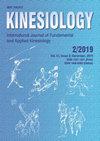青年精英足球运动员踢球能力与踢球缺陷
IF 0.9
4区 医学
Q4 REHABILITATION
引用次数: 9
摘要
在足球比赛中,踢球能力主要是通过最大球速度来评价的。踢腿缺陷(KD)可以定义为每个球员通过非首选踢腿与首选踢腿所获得的最大球速度之差的百分比。这项研究旨在比较14岁以上的年轻(G-14)和年长(G+14)足球运动员的左右踢速度、垂直跳跃和人体测量学。另一个目的是调查这些变量之间的关联。参与者是来自西班牙顶级联赛俱乐部发展计划的92名年轻精英足球运动员。按发育阶段分为两组(10.80 ~ 13.55岁,n=46;14.02-16.39年,n=46)。学生t检验显示,与G-14相比,G+14的首选腿和非首选腿的最大踢腿速度、跳跃性能和所有人体测量值均显著(p< 0.01)提高。相比之下,KD值保持稳定(15.31% ~ 15.83%),各组间无显著差异。Pearson相关分析显示,垂直跳跃测试和人体测量与首选腿和非首选腿产生的踢球速度相关。我们的研究结果表明,踢球技术仍然没有得到巩固,力量因素可能是决定踢球表现的青少年足球运动员。此外,对于14岁以下和14岁以上的足球运动员来说,KD可能是一个恒定的因素,这可能是由于与非首选腿相比,首选腿的使用不平等和更多。关键词:球速度,技巧,表现,跳跃,非首选腿,力量本文章由计算机程序翻译,如有差异,请以英文原文为准。
Kicking ability and kicking deficit in young elite soccer players
Kicking ability in soccer has been evaluated predominantly by the maximum ball velocity. The kicking deficit (KD) may be defined as the percentage of the difference between the maximum ball velocity each player achieved by the non-preferred leg kick in relation to the preferred leg kick. This study aimed to compare: side-to-side kicking velocity, vertical jumps and anthropometrics between the younger (G-14) and older (G+14) than 14 years soccer players. An additional aim was to investigate associations among these variables. Participants were 92 young elite soccer players from the development programme of a top Spanish division club. They were divided into two age groups according to their growth and motor development stages (10.80-13.55 years, n=46; 14.02-16.39 years, n=46). Student’s t-test showed that the maximum kicking velocity with the preferred and non-preferred leg, jumping performance, and all anthropometric measurements were significantly (p<.01) higher in G+14 compared with G-14. In contrast, KD values remained stable (15.31%- 15.83%) without significant differences between the groups. Pearson’s correlation analysis revealed that vertical jump tests and anthropometric measurements correlated with kicking ball velocity produced by the preferred and non-preferred leg. Our results demonstrate that kicking skills are still not consolidated and power factors may be determinant for kicking performance in young soccer players. In addition, the KD may be a constant element for both the under and above 14 years soccer players and could result from an unequal and greater use of the preferred leg in comparison with the non-preferred leg.
Key words: ball velocity, skill, performance, jumping, non-preferred leg, strength
求助全文
通过发布文献求助,成功后即可免费获取论文全文。
去求助
来源期刊

Kinesiology
REHABILITATION-SPORT SCIENCES
CiteScore
1.90
自引率
8.30%
发文量
16
审稿时长
>12 weeks
期刊介绍:
Kinesiology – International Journal of Fundamental and Applied Kinesiology (print ISSN 1331- 1441, online ISSN 1848-638X) publishes twice a year scientific papers and other written material from kinesiology (a scientific discipline which investigates art and science of human movement; in the meaning and scope close to the idiom “sport sciences”) and other adjacent human sciences focused on sport and exercise, primarily from anthropology (biological and cultural alike), medicine, sociology, psychology, natural sciences and mathematics applied to sport in its broadest sense, history, and others. Contributions of high scientific interest, including also results of theoretical analyses and their practical application in physical education, sport, physical recreation and kinesitherapy, are accepted for publication. The following sections define the scope of the journal: Sport and sports activities, Physical education, Recreation/leisure, Kinesiological anthropology, Training methods, Biology of sport and exercise, Sports medicine and physiology of sport, Biomechanics, History of sport and Book reviews with news.
 求助内容:
求助内容: 应助结果提醒方式:
应助结果提醒方式:


